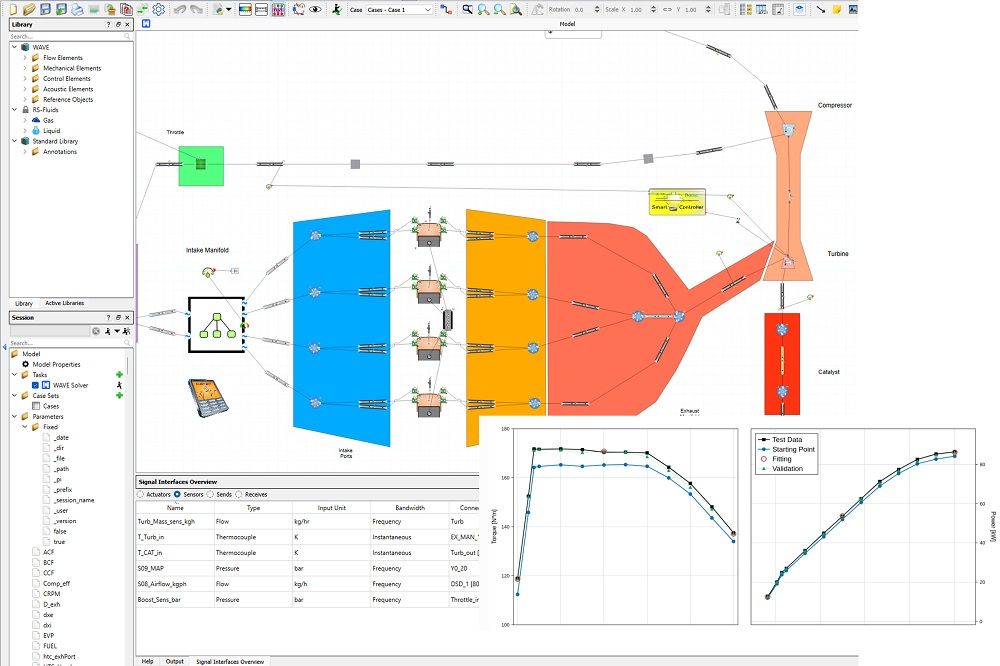WAVE
High Fidelity 1D CFD Engine Modelling
Highlights
- Advanced 1D engine cycle simulation software used throughout the IC engine industry
- Library of elements for modeling flow and combustion in engines
- Intake and exhaust design for noise reduction, engine boosting (turbocharger, supercharger), variable valve timing system design, thermal analysis, combustion, and emissions predictions
- Time-step-level integration with MATLAB® and Simulink®, enabling engine control systems to be developed using a more accurate engine model
- Ability to model sustainable and non-carbon fuels
- With WAVE-RT, ability to embed a real-time variant of the WAVE model within a Simulink model for control system validation in SIL and HIL simulations
Description
WAVE and its faster than real-time component WAVE-RT are at the forefront of 1D CFD technology for the analysis of Internal Combustion Engines (ICE). Combining precision and user friendliness, engineers are empowered to forge intricate digital engine twins that epitomize design concepts. This capability proves invaluable for tasks such as analysis, optimization, calibration, diagnostics, and maintenance of IC engines. Prioritizing the precision of simulation and including targeted capabilities aimed at sustainable and non-carbon fuel modeling, WAVE finds applications across diverse industrial sectors, such as automotive, aerospace, rail, motorsport, marine, and power generation. The commitment of WAVE to customer satisfaction propels the transition towards virtual product development, enabling engineers to embrace cutting-edge innovations and accelerated R&D, all while curbing development costs.
WAVE supports the ability to co-simulate with MATLAB and Simulink, including running multiple variants or instances of the WAVE model. This approach allows users to perform detailed modeling of the complete engine management system and driveline. From the WAVE engine model, numerical sensors output pressure, temperature, air/fuel ratio, and many other variables to a Simulink model of the controller. Simulink then returns signals to control fueling, load, throttle position, and other attributes. This interface allows a WAVE engine model to be driven by an external process within a complete engine/ECU/vehicle simulation, enabling engineers to design and optimize the control algorithm and engine/transmission using WAVE as a physical plant model. Thus, WAVE allows users to analytically determine the proper dynamic response of the system rather than rely on approximations derived from simplified engine representation or on data acquired from engine testing.
When the controller design is complete, WAVE-RT can be used to create a real-time variant of the model, with full crank-angle resolution of gas flow and combustion events. This enables the same WAVE model to be used in the complete workflow from engine system design through control system validation.

Realis Simulation Ltd.
Realis Simulation, formerly Ricardo Software
Building 50, Shoreham Technical Centre
Shoreham-By-Sea
West Sussex, BN43 5FG
UNITED KINGDOM
contact@realis-simulation.com
www.realis-simulation.com
Required Products
Platforms
- UNIX
- Windows
Support
- On-site assistance
- Telephone
- Training
Product Type
- Data Analysis Tools
- Modeling and Simulation Tools
Tasks
- Acoustics
- Mechanics and Compression Systems
- System Modeling and Simulation
Industries
- Aerospace and Defense
- Automotive
- Industrial Automation and Machinery
- Rail, Ships, and Other Transportation
